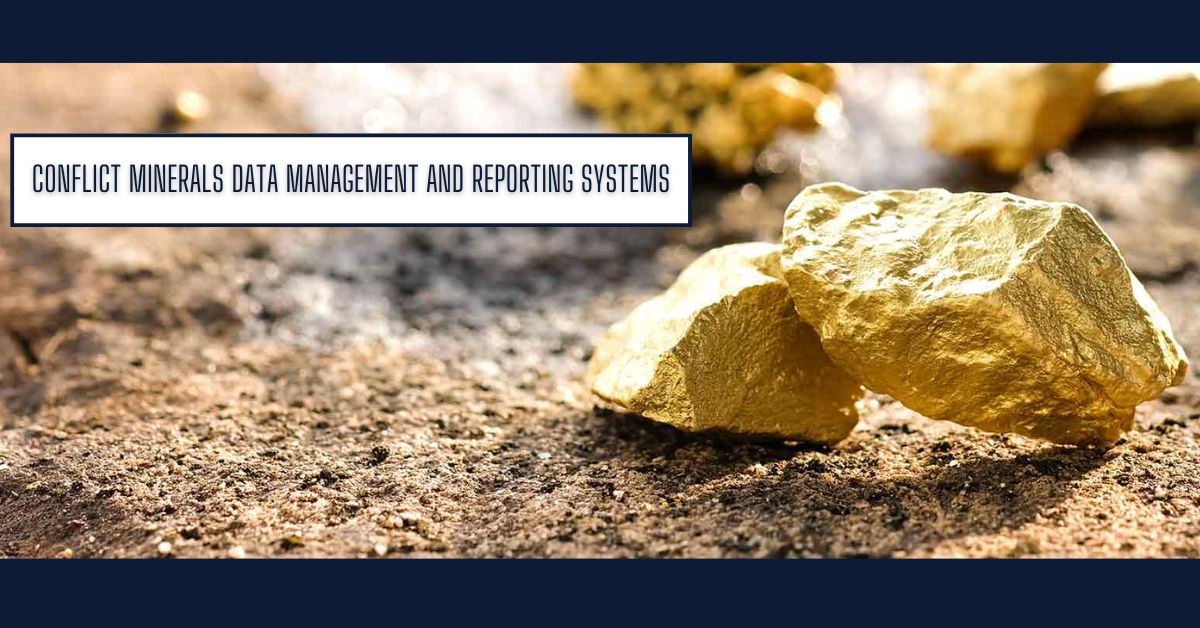
In recent years, global attention has increasingly focused on conflict minerals—specifically tin, tantalum, tungsten, and gold (often referred to as 3TG)—due to their association with human rights abuses and armed conflicts in certain regions. Governments, regulatory bodies, and consumers alike are demanding greater transparency and accountability from companies regarding the sourcing and use of these minerals. This article delves into the importance of conflict minerals data management and reporting systems, exploring how organizations can effectively implement these systems to comply with regulations, mitigate risks, and uphold ethical standards. Conflict mineral compliance enhances corporate reputation and fosters sustainable and responsible practices throughout the supply chain, contributing to global efforts to address humanitarian and environmental concerns.
Understanding Conflict Minerals and Regulatory Requirements
Conflict minerals originate primarily from conflict-affected and high-risk areas, particularly in the Democratic Republic of Congo (DRC) and adjoining countries. Their extraction and trade have been linked to funding armed groups and perpetuating violence, leading to international efforts to regulate their sourcing and trade. Regulatory frameworks such as the Dodd-Frank Wall Street Reform and Consumer Protection Act in the United States and the EU Conflict Minerals Regulation impose reporting obligations on companies that use 3TG minerals in their products.
Importance of Data Management Systems in Conflict Minerals Compliance
Effective data management systems are essential for companies to comply with conflict minerals regulations and demonstrate due diligence in their supply chains. These systems enable organizations to collect, validate, analyze, and report on relevant data related to the origin and chain of custody of conflict minerals used in their products. By maintaining accurate and up-to-date records, companies can trace the journey of minerals from mine to market, identify risks of financing armed conflict, and ensure responsible sourcing practices.
Components of Conflict Minerals Data Management Systems
1. Data Collection and Documentation:
Data management systems facilitate the collection of information from suppliers regarding the presence and origin of conflict minerals in raw materials or components. Companies establish clear documentation requirements and engage with suppliers to obtain detailed declarations and certificates of conformity. This data serves as the foundation for due diligence processes and regulatory reporting.
2. Traceability and Chain of Custody:
Traceability mechanisms within data management systems track the movement of conflict minerals through the supply chain. Companies use unique identifiers, such as lot numbers or barcodes, to link minerals to their original sources and monitor their journey through processing and manufacturing stages. Chain of custody documentation ensures transparency and accountability in mineral sourcing practices.
3. Risk Assessment and Mitigation:
Data management systems include tools for conducting risk assessments to identify high-risk suppliers or regions associated with conflict minerals. Companies evaluate supplier responses, conduct site visits or audits where necessary, and assess the effectiveness of supplier due diligence practices. Risk mitigation strategies may involve diversifying supply sources, supporting responsible mining initiatives, or engaging in multi-stakeholder collaborations.
4. Reporting and Disclosure:
Robust data management systems facilitate the generation of comprehensive reports that document compliance with conflict minerals regulations. Companies prepare annual disclosures detailing the due diligence measures undertaken, the percentage of conflict-free minerals sourced, and efforts to support responsible mineral supply chains. Transparent reporting enhances corporate accountability and builds trust with stakeholders, including investors, customers, and regulatory authorities.
Implementing Effective Conflict Minerals Data Management Systems
1. Establish Clear Policies and Procedures:
Companies should develop internal policies and procedures that outline responsibilities, roles, and expectations related to conflict minerals compliance. Clear guidelines help standardize data collection methods, ensure consistency across supply chain partners, and facilitate continuous improvement in due diligence practices.
2. Utilize Technology and Automation:
Deploying specialized software solutions for conflict minerals data management streamlines data collection, analysis, and reporting processes. These technologies automate data validation, integrate with supplier management systems, and provide real-time visibility into supply chain activities. Automation reduces manual errors, accelerates response times, and enhances overall efficiency in compliance efforts.
3. Engage Stakeholders and Collaboration:
Effective conflict minerals management requires collaboration with stakeholders, including suppliers, industry associations, civil society organizations, and government agencies. Engaging stakeholders fosters knowledge sharing, promotes best practices in responsible sourcing, and supports industry initiatives aimed at improving transparency and ethical standards in mineral supply chains.
4. Continuous Monitoring and Improvement:
Regular monitoring and evaluation of data management systems are critical to identifying areas for improvement and adapting to evolving regulatory requirements. Companies conduct internal audits, review performance metrics, and solicit feedback from stakeholders to assess the effectiveness of their conflict minerals compliance programs. Continuous improvement initiatives ensure ongoing compliance, mitigate risks, and enhance the integrity of mineral supply chain disclosures.
Conclusion
In conclusion, effective conflict minerals data management and reporting systems are indispensable tools for companies committed to ethical sourcing practices and regulatory compliance. By implementing robust systems that facilitate data collection, traceability, risk assessment, and transparent reporting, organizations can mitigate the risks associated with conflict minerals, uphold human rights standards, and strengthen their corporate reputation. As global scrutiny of mineral supply chains intensifies, investing in comprehensive data management solutions not only ensures compliance with current regulations but also positions companies as leaders in responsible supply chain management and sustainable business practices.







